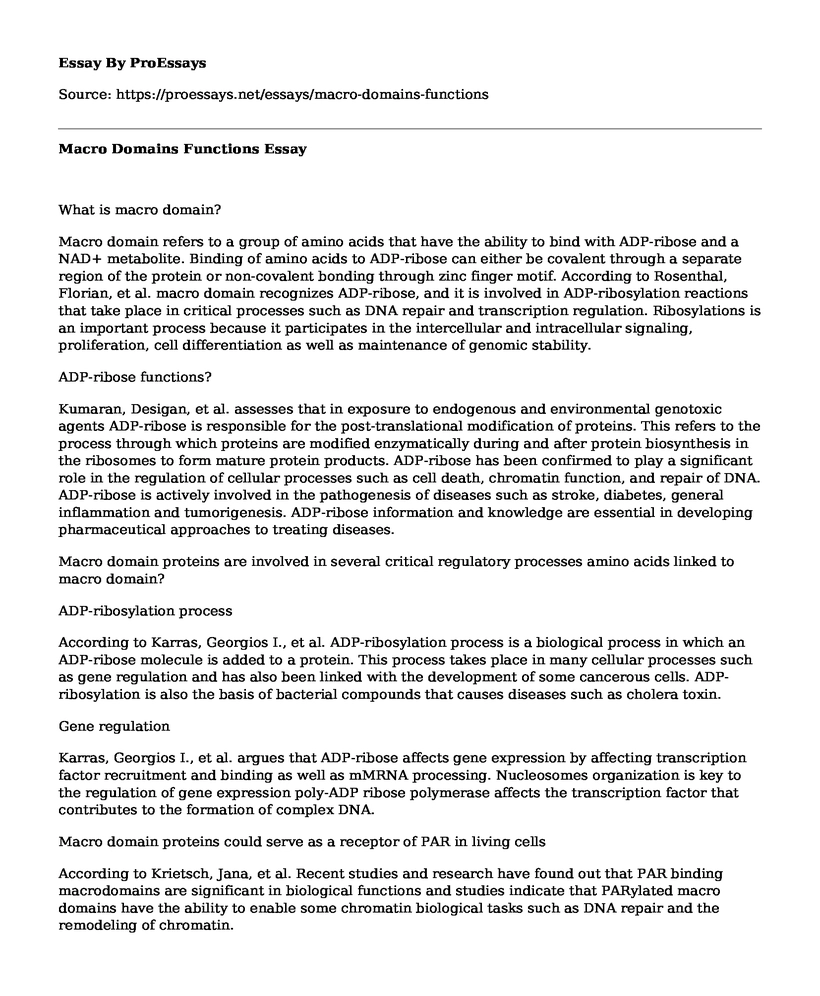What is macro domain?
Macro domain refers to a group of amino acids that have the ability to bind with ADP-ribose and a NAD+ metabolite. Binding of amino acids to ADP-ribose can either be covalent through a separate region of the protein or non-covalent bonding through zinc finger motif. According to Rosenthal, Florian, et al. macro domain recognizes ADP-ribose, and it is involved in ADP-ribosylation reactions that take place in critical processes such as DNA repair and transcription regulation. Ribosylations is an important process because it participates in the intercellular and intracellular signaling, proliferation, cell differentiation as well as maintenance of genomic stability.
ADP-ribose functions?
Kumaran, Desigan, et al. assesses that in exposure to endogenous and environmental genotoxic agents ADP-ribose is responsible for the post-translational modification of proteins. This refers to the process through which proteins are modified enzymatically during and after protein biosynthesis in the ribosomes to form mature protein products. ADP-ribose has been confirmed to play a significant role in the regulation of cellular processes such as cell death, chromatin function, and repair of DNA. ADP-ribose is actively involved in the pathogenesis of diseases such as stroke, diabetes, general inflammation and tumorigenesis. ADP-ribose information and knowledge are essential in developing pharmaceutical approaches to treating diseases.
Macro domain proteins are involved in several critical regulatory processes amino acids linked to macro domain?
ADP-ribosylation process
According to Karras, Georgios I., et al. ADP-ribosylation process is a biological process in which an ADP-ribose molecule is added to a protein. This process takes place in many cellular processes such as gene regulation and has also been linked with the development of some cancerous cells. ADP-ribosylation is also the basis of bacterial compounds that causes diseases such as cholera toxin.
Gene regulation
Karras, Georgios I., et al. argues that ADP-ribose affects gene expression by affecting transcription factor recruitment and binding as well as mMRNA processing. Nucleosomes organization is key to the regulation of gene expression poly-ADP ribose polymerase affects the transcription factor that contributes to the formation of complex DNA.
Macro domain proteins could serve as a receptor of PAR in living cells
According to Krietsch, Jana, et al. Recent studies and research have found out that PAR binding macrodomains are significant in biological functions and studies indicate that PARylated macro domains have the ability to enable some chromatin biological tasks such as DNA repair and the remodeling of chromatin.
The transcriptional roles of macrodomain proteins
Krietsch, Jana, et al. notes that studies have found out that post-translational modification is important in the process of gene expression. Specifically, translational modification helps regulate the structure of the chromatin and transcription of nuclei metazoan cells. Enzymes catalyze ADP-ribose into proteins through mono-ADP-ribosylation which occurs mainly in the cytoplasm and poly-ADP-ribosylation which plays a significant function in gene repair and transcriptional activation.
Macro domains in cancer and degenerative diseases
Rosenthal, Florian, et al. argues that several macro domains have been linked to malignant disease due to their quick evolution. ADP-ribosyltransferase family is largely associated with cancer development and progression. In high-risk conditions, macro domain proteins diffuse large B-cell lymphomas which promote interleukin-4 dependent B cell resulting in the co-regulating expression of genes. Macro domains have been found to be abundant in viruses such as coronaviruses and hepatitis E virus which have been associated with cancerous cell growth.
Macro domain in infectious diseases
Rosenthal, Florian, et al. assesses that coronaviruses have been found by research to contain ADP-ribose -1 phosphatase, coronaviruses are major causes of human and veterinary diseases. Research has found that macro domain proteins are significant in the replication of disease-causing viruses. Understanding the mechanism through which macro domain proteins promote viral pathogenesis can help create new avenues for therapies to treat diseases.
Work Cited
Egloff, Marie-Pierre, et al. "Structural and functional basis for ADP-ribose and poly (ADP-ribose) binding by viral macro domains." Journal of virology 80.17 (2006): 8493-8502.
Karras, Georgios I., et al. "The macro domain is an ADPribose binding module." The EMBO journal 24.11 (2005): 1911-1920.
Krietsch, Jana, et al. "Reprogramming cellular events by poly (ADP-ribose)-binding proteins." Molecular aspects of medicine 34.6 (2013): 1066-1087.
Kumaran, Desigan, et al. "Structure and mechanism of ADPribose1 monophosphatase (Appr1 pase), a ubiquitous cellular processing enzyme." Protein science 14.3 (2005): 719-726.
Rosenthal, Florian, et al. "Macrodomain-containing proteins are new mono-ADP-ribosylhydrolases." Nature structural & molecular biology 20.4 (2013): 502-507.
Cite this page
Macro Domains Functions. (2021, Mar 26). Retrieved from https://proessays.net/essays/macro-domains-functions
If you are the original author of this essay and no longer wish to have it published on the ProEssays website, please click below to request its removal:
- Why Human Genetic Engineering Should Be Allowed for Medical Purposes
- Paper Example on Parvocellular Stream and Motion Sensitivity Experiment
- The Kidney Role in Homeostasis - Paper Example
- Essay on Illegal Hunting & Trade of Endangered Species in Africa: Causes & Consequences
- Harvest Rainwater Easily: Simple & Fancy Rain Barrels for Runoff Control - Essay Sample
- Exploring the National Park: A Memorable Adventure - Essay Sample
- Surviving Off The Land: Necessary Knowledge for Modern Living - Essay Sample







